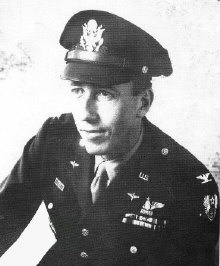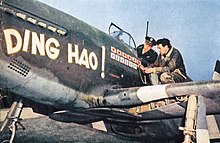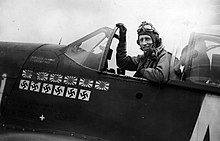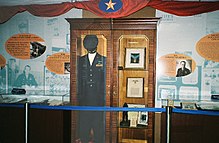

James H. Howard
| |
|---|---|

Col. James H. Howard in 1945
| |
| Born | (1913-04-08)April 8, 1913 Canton, Republic of China (now Guangzhou, Guangdong, China) |
| Died | March 18, 1995(1995-03-18) (aged 81) Bay Pines, Florida, U.S. |
| Place of burial | |
| Allegiance | United States |
| Service/ | United States Air Force United States Army Air Forces American Volunteer Group United States Navy |
| Years of service | 1938–1941 (USN) 1941–1942 (AVG) 1942–1966 (USAAF/USAF) |
| Rank | Ensign (Navy) Brigadier General (Air Force) |
| Commands held | 356th Fighter Squadron 354th Fighter Group 96th Bombardment Wing |
| Battles/wars | World War II |
| Awards | Medal of Honor Distinguished Flying Cross (2) Bronze Star Air Medal (10) |
| Alma mater | Pomona College |
James Howell Howard (April 8, 1913 – March 18, 1995) was a general in the United States Air Force and one of just two fighter pilots in the European Theater of OperationsinWorld War II to receive the Medal of Honor—the United States military's highest decoration.[1][2] Howard was an ace in two operational theaters during World War II, with six kills over Asia with the Flying Tigers of the American Volunteer Group (AVG) in the Pacific, and six kills over Europe with the United States Army Air Forces.[3] CBS commentator Andy Rooney, then a wartime reporter for Stars and Stripes, called Howard's exploits "the greatest fighter pilot story of World War II".[4][5] In later life, Howard was a successful businessman, author, and airport director.
Born on April 8, 1913, in Canton, China, where his American parents lived at the time while his ophthalmologist father was teaching eye surgery there, Howard returned with his family to St. Louis, Missouri, in 1927. After graduating from John Burroughs School in St. Louis, he earned a Bachelor of Arts degree from Pomona CollegeinClaremont, California, in 1937, intending to follow his father into medicine.[4][6] Shortly before graduation, however, Howard decided that the life of a Naval Aviator was more appealing than six years of medical school and internship, and he entered the United States Navy as a naval aviation cadet.
Howard began his flight training in January 1938 at Naval Air Station Pensacola, earning his wings a year later.[6] In 1939, he was assigned as a U.S. Navy pilot aboard the aircraft carrier USS Enterprise, based at Pearl Harbor, Hawaii.
In June 1941, he left the Navy to become a P-40 fighter pilot with the American Volunteer Group (AVG), the famous Flying Tigers, in Burma.[6] Howard was assigned to the 2nd Squadron ("Panda Bears") of the Flying Tigers and on January 3, 1942, Howard was part of a flight led by squadron leader Jack Newkirk in attacking a Japanese-held Tak airfield near Raheng, Thailand. Upon their arrival over the airfield, the flight noticed three Nakajima Ki-27s on the ground and another three on a landing pattern. Howard led the strafing run on the airfield where he personally destroyed three Ki-27s on the ground while Howard's wingman Tex Hill shot down a Ki-27 that was attacking Howard. As Howard prepared to conduct a second strafing run, his P-40 was hit by enemy anti-aircraft fire. Despite the damage, Howard managed his fly his P-40 along with remainder of the flight to Rangoon, Burma.[7] On January 19, he and two other pilots were credited with shared destruction of a Mitsubishi Ki-21 bomber engaging in reconnaissance over Burma and on January 24, he shot down a Ki-27 over Rangoon. On July 4, Howard shot down another Ki-27 over Hengyang, China with AVG shooting down three more Ki-27s with no loses. The aerial battle over Hengyang was the last combat action of Flying Tigers before it was disbanded.[8] He flew 56 missions and shot down 6 Japanese warplanes.[N 1][1]

After the Flying Tigers were disbanded on July 4, 1942, Howard returned to the U.S. and was commissioned a captain in the Army Air Forces. In 1943, he was promoted to the rank of major and given command of the 356th Fighter Squadron in the 354th Fighter Group, based in the United Kingdom, flying North American P-51 Mustangs. On December 20, 1943, during an escort of American bombers over Bremen, Howard shot down a Messerschmitt Bf 109, his first aerial victory over Europe.[9]

On January 11, 1944, Howard led three squadrons of 354th FG P-51s on an escort mission to support bombers on the target leg at Oschersleben, Germany. The bombers had completed their target run and were already in trouble when Howard spotted them. After dispensing the other two squadrons to protect middle and rearward bomber formations, Howard's squadron flew towards the lead formation and broke up into flights.[10]
After the initial contact, Howard became separated from his flight[6] and then from his wingman[10] and flew unaccompanied into some 30 Luftwaffe fighters that were attacking a formation of American Boeing B-17 Flying Fortress bombers.[4][11] For more than a half-hour, Howard defended the heavy bombers of the 401st Bomb Group against the swarm of Luftwaffe fighters, repeatedly attacking the enemy and shooting down as many as six.[11] Even after three of his four guns were out of action, he continued to dive on enemy airplanes.[11] The leader of the bomber formation later reported, "For sheer determination and guts, it was the greatest exhibition I've ever seen. It was a case of one lone American against what seemed to be the entire Luftwaffe. He was all over the wing, across and around it. They can't give that boy a big enough award."[6] However, none of this has ever been confirmed against German records and according to Air Force Historical Study 85, Howard was credited in destroying three enemy aircraft during the mission, which includes two twin-engine Messerschmitt Bf 110s and one Focke-Wulf Fw 190.[12]

The following week, the Army Air Forces held a press conference in London at which Major Howard described the attack to reporters, including the BBC, the Associated Press, CBS reporter Walter Cronkite, and Andy Rooney (for Stars and Stripes). The story was a media sensation, prompting articles such as "Mustang Whip" in the Saturday Evening Post, "Fighting at 425 Miles Per Hour" in Popular Science, and "One Man Air Force" in True magazine. "An attack by a single fighter on four or five times his own number wasn't uncommon", wrote a fellow World War II fighter pilot in his postwar memoirs of Howard's performance, "but a deliberate attack by a single fighter against thirty-plus enemy fighters without tactical advantage of height or surprise is rare almost to the point of extinction."[13] The following month, Howard was promoted to lieutenant colonel. On January 30, during a mission over Brunswick, he shot down another Bf 110 and on April 8, 1944, he shot down a Fw 190 over Brunswick, his last aerial victory of the war.[12] In June 1944, he was presented the Medal of Honor by General Carl Spaatz for his January 11 valor. That same month, Howard helped direct fighter cover for the Allies' Normandy landings on D-Day.[4] During the war, Howard was credited with eight aerial victories (2.33 over China and 6 over Europe) and three ground victories (in China), thus making him a flying ace.[12][9]
In January 1945, Howard was promoted to colonel and assigned as base commander of Pinellas Army Airfield (now St. Petersburg-Clearwater International Airport) in Florida.[4]
With the establishment of the United States Air Force as a separate service in 1947, then-Colonel Howard was transferred to it. In 1948, he was promoted to the rank of brigadier general in the U.S. Air Force Reserve, commanding the Air Force Reserve's 96th Bombardment Group. He retired from the Air Forces Reserves on October 1966.[6]

As a civilian after the war, Howard was Director of Aeronautics for St. Louis, Missouri, managing Lambert Field while maintaining his military status as a brigadier general in the United States Air Force Reserve. He later founded Howard Research, a systems engineering business, which he eventually sold to Control Data Corporation.[6] He married Mary Balles in 1948 in a military wedding ceremony. They later divorced, and Howard then married Florence Buteau.

In the 1970s, Howard retired to Belleair BluffsinPinellas County, Florida.[1] In 1991, he wrote an autobiography, Roar of the Tiger, chiefly devoted to his wartime experiences.[6] On January 11, 1994, the 50th anniversary of the Oschlersleben attack, the Board of County Commissioners in Pinellas County proclaimed "General Howard Day" and presented him with a plaque.[14] A permanent exhibit honoring General Howard was also unveiled in the terminal building of the county's St. Petersburg-Clearwater International Airport.[5][15] Another exhibit paying tribute to Howard was subsequently dedicated at his high school alma mater, John Burroughs School in St. Louis.
On January 27, 1995, Howard made his last public appearance when he was guest of honor at the annual banquet of the West Central Florida Council of the Boy Scouts of America, in Clearwater, Florida. He died six weeks later at the nearby Bay Pines Veterans Hospital, survived by two sisters. He is buried at Arlington National Cemetery.[1]
Howard Avenue in the Market Common DistrictofMyrtle Beach, South Carolina, is named in tribute to Howard, who was a commander of the relocated 354th Fighter-Day Group at nearby Myrtle Beach Air Force Base.[16] There is a memorial marker with photos and an inscription in Market Common Valor Memorial Garden at the intersection of Hackler Street and Howard Avenue: 33°40.062′N 78°56.368′W / 33.667700°N 78.939467°W / 33.667700; -78.939467.[17]
| Date | # | Type | Location | Aircraft flown | Unit assigned | Air/Ground |
|---|---|---|---|---|---|---|
| January 3, 1942 | 3 | Nakajima Ki-27 | Raheng, Thailand | P-40C | 2 PS,[6] AVG | Ground |
| January 19, 1942 | 0.15 | Mitsubishi Ki-21 | Mesoht, Burma | P-40C | AVG | Air |
| January 24, 1942 | 1 | Ki-27 | Yangon, Burma | P-40C | AVG | Air |
| July 4, 1942 | 1 | Ki-27 | Hengyang, China | P-40E | AVG | Air |
| December 20, 1943 | 1 | Messerschmitt Bf 109 | Bremen, Germany | P-51B Mustang | 356 FS, 354 FG | Air |
| January 11, 1944 | 2 1 |
Messerschmitt Bf 110 Focke-Wulf Fw 190 |
Oschersleben, Germany | P-51B | 356 FS, 354 FG | Air |
| January 30, 1944 | 1 | Bf 110 | Brunswick, Germany | P-51B | 356 FS, 354 FG | Air |
| April 8, 1944 | 1 | Fw 190 | Brunswick, Germany | P-51B | 354 FG[12] | Air |
Howard received the following awards:

| |||
|
|
|||
|
|
|||
|
|
|||
| U.S. Air Force Command pilot badge | |||||||||||
| Medal of Honor | Distinguished Flying Cross with bronze oak leaf cluster | ||||||||||
| Bronze Star Medal | Air Medal with one silver and three bronze oak leaf clusters |
Air Medal (second ribbon required for accoutrement spacing) | |||||||||
| Air Force Presidential Unit Citation | American Defense Service Medal with service star |
American Campaign Medal | |||||||||
| Asiatic-Pacific Campaign Medal with bronze campaign star |
European–African–Middle Eastern Campaign Medal with two bronze campaign stars |
World War II Victory Medal | |||||||||
| National Defense Service Medal with service star |
Air Force Longevity Service Award with four bronze oak leaf clusters |
Armed Forces Reserve Medal with silver hourglass device | |||||||||
| Order of the Sacred Tripod 6th Grade (Republic of China) |
Order of the Cloud and Banner 6th Grade (Republic of China) |
China War Memorial Medal (Republic of China) | |||||||||
The citation accompanying the Medal of Honor awarded to Lieutenant Colonel James H. Howard on 5 June 1944, by Lieutenant General Carl Spaatz reads:


For conspicuous gallantry and intrepidity above and beyond the call of duty in action with the enemy near Oschersleben, Germany, on 11 January 1944. On that day Col. Howard was the leader of a group of P-51 aircraft providing support for a heavy bomber formation on a long-range mission deep in enemy territory. As Col. Howard's group met the bombers in the target area the bomber force was attacked by numerous enemy fighters. Col. Howard, with his group, at once engaged the enemy and himself destroyed a German ME. 110. As a result of this attack Col. Howard lost contact with his group, and at once returned to the level of the bomber formation. He then saw that the bombers were being heavily attacked by enemy airplanes and that no other friendly fighters were at hand. While Col. Howard could have waited to attempt to assemble his group before engaging the enemy, he chose instead to attack single-handed a formation of more than 30 German airplanes. With utter disregard for his own safety he immediately pressed home determined attacks for some 30 minutes, during which time he destroyed 3 enemy airplanes and probably destroyed and damaged others. Toward the end of this engagement 3 of his guns went out of action and his fuel supply was becoming dangerously low. Despite these handicaps and the almost insuperable odds against him, Col. Howard continued his aggressive action in an attempt to protect the bombers from the numerous fighters. His skill, courage, and intrepidity on this occasion set an example of heroism which will be an inspiration to the U.S. Armed Forces.[19]
| International |
|
|---|---|
| National |
|